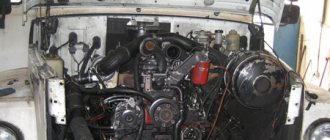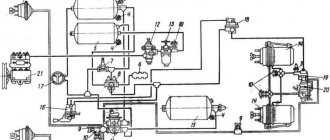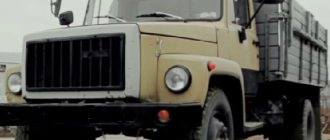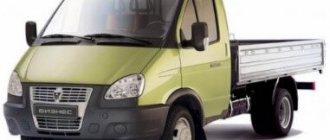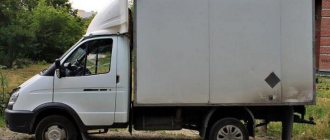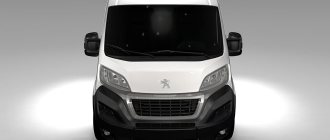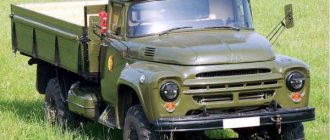While rummaging through the Internet I found this information, I think it will be useful to everyone.
Power unit assembly (with gearbox and transfer case)
GAZ-67 engine with gearbox and transfer case (transfer case is integrated into the gearbox) - 248 kg GAZ-69 engine with gearbox and transfer case - 280 kg GAZ-66 engine with gearbox and transfer case - 380 kg ZIL-130 engine (431410) with gearbox and parking brake - 640 kg UAZ-3151 (UMZ-4179) engine with gearbox and transfer case - 240 kg Engine
GAZ-66 engine - 275 kg ZIL-130 engine (431410) - 500 kg UAZ-3151 engine (UMZ-4179) - 165 with clutch Mitsubishi 4D56 engine - 215 kg Mitsubishi 4G64 engine - 195 kg Mitsubishi 4M40 engine - 2 70 kg Mitsubishi engine 6G72 - 225 kg Nissan TD27 engine - 250 kg Nissan RD28 engine - 255 kg Nissan TD42 engine - 365 kg Toyota 1HDFTE engine - 365 kg HUYNDAI D4BH engine - 220 kg VAZ engine 21214-1000260-32 - 134.5 kg VAZ engine 21213- 1000260-00 - 124 kg VAZ 2121 engine - 114 kg
GAZ-66 gearbox - 56 kg ZIL-130 gearbox (431410) without parking brake - 98 kg GAZ-69 gearbox - 28 kg UAZ 3151 gearbox - 36 kg Mitsubishi V5MT1 gearbox (manual transmission) with SuperSelect transfer case - 110 kg Mitsubishi V4AW3 gearbox (automatic transmission) with SuperSelect transfer case - 140 kg VAZ-2121 gearbox (with clutch housing) - 32 kg
Transfer case GAZ-66 - 49 kg, with brake 57 Transfer case UAZ-3151 with brake - 37 Transfer case GAZ-69 - 43 Transfer case VAZ-2121 - 27.6 kg
Cooling system radiator
Radiator ZIL-130 (431410) - 21 kg Radiator GAZ-53 - 21 kg Radiator VAZ-2121 - 7 kg Radiator GAZ-24 - 10 kg Radiator GAZ-69 - 16 kg
Frame GAZ-69 - 125 Frame GAZ-66 - 290 Frame UAZ-3151 - 112
Fuel tank 21213 with sensor - 4.8 kg Fuel tank Gazelle, GAZ-3307, GAZ-66 100l universal - 14 kg Fuel tank UAZ-3303 onboard - 9.1 kg Fuel tank UAZ-469 left assembled 7.2 kg
complete body (1 set)
GAZ-69 body — 409 GAZ-66 cabin assembly — 360 VAZ-2121 body assembly — 520 UAZ-3151 body assembly — 475 UAZ Patriot body assembly — 760 UAZ Hunter body assembly (rear swing door) — 590 Body UAZ-31514-84 (with a metal roof, soft seats, folding tailgate) - 587 kg UAZ-3303 cab (flatbed) assembled (with seats) - 268 UAZ-3741 body (manufactured goods non-glazed van) - 592 UAZ cab- 39094 Farmer (5-seater double cabin) - 610 UAZ 3962 body (nurse, glazed, with folding benches) - 765 bare body (frame, 3rd set)
Body with frame Pajero II shorty V24W (frame, 3rd set) -415 kg Painted body frame UAZ Patriot - 420 Boat UAZ 31512 (469), under an awning - 249 Body frame UAZ Hunter (rear swing door) - 241 Body frame UAZ-31514 (tailgate) - 249 Cabin UAZ-3303 (side) frame - 160 Body frame UAZ-3741 (manufactured goods non-glazed van) - 400 Cabin UAZ-39094 Farmer (5-seater double cab, frame) - 180 Body frame UAZ 3962 (nurse, glazed, with folding benches) - 400 Removable roof
Roof of UAZ 3151-40 under a tailgate with upholstery and glazing - 91 kg Roof of UAZ 3151-95 under a rear hinged door with upholstery and glazing - 83 kg
Hood without noise insulation MMC Pajero II without nostrils - 17.7 kg GAZ-69 hood - 12 kg VAZ-2121 hood - 15 kg UAZ-3163 hood (Patriot) - 15.8 kg UAZ-469 hood - 13.1 kg
Front fender MMC Pajero II dorestayl, without extension (fender) - 4.8 kg Front fender VAZ-2121 - 5.8 kg Wing UAZ 469 - 4.3 kg Wing UAZ Patriot 3163 - 5.2 kg
Trunk door VAZ-21214 (naked) - 8.5 kg Trunk door UAZ-3162 (naked) - 22 kg
Door UAZ-3160, Patriot front (naked) - 17.7 kg Door VAZ-21214 (naked) - 14.4 kg Windshield
Windshield MMC Pajero II - 11.5 kg
Rear axle assembly with brakes
Rear axle GAZ-66 — 250 Rear axle GAZ-69 — 90 Rear axle UAZ-31512 (collective farm) — 100 Rear axle UAZ-3151 (military) — 122 Axle VOLVO Laplander 170 Rear axle MMC Pajero 9.5″ (spring suspension) — 115 Rear axle MMC Pajero 8″ (spring suspension) — 95 Rear axle MMMC Pajero 8″ (spring suspension, LSD) with oil, handbrake cables — 93 Rear axle VAZ-2121 — 60 kg
Front axle GAZ-66 330 kg Front axle GAZ-69 120 kg Front axle UAZ-31512 (collective farm) - 120 kg Front axle UAZ-3151 (military) - 140 kg Front axle VAZ-2121 (with front wheel drive) - 32 kg
GAZ-66 cardan drive - 36 kg UAZ-3151 driveshafts - 15 kg
Wheel (standard, factory)
Wheel with GAZ-69 tire - 30 Wheel with GAZ-67 tire - 29 Wheel with UAZ-3151 tire - 39 Wheel with GAZ-66 tire - 118 Wheel with VAZ-2121 tire - 21
wheel disk (factory)
steel VAZ-2121 16″ — 8.7 kg steel VAZ-2123 15″ — 9.0 kg steel UAZ-452-3101015-01 15″ — 11.7 kg steel UAZ-452-3101015 16″ — 13.1 kg cast MMC Pajero II 7×15″ - 9.5 kg
Dump truck GAZ-3307: history
The management of the Gorky plant realized the need for changes in the design of equipment in the 80s. Since that time, the development of cars began, mainly unified with third-generation models, but more productive and powerful. Thanks to the actual transfer of main components from one generation of equipment to another, it was possible to reduce the cost of repairs, spare parts and interservice maintenance of machines.
Meeting the requirements of the time, the GAZ-3307 offered the user a spacious double cabin with ventilation and heating. At the end of 1989, mass production of the 3307 model with a factory ZMZ engine and 4x2 wheel arrangement was launched. The vehicle had a carrying capacity of 4.5 tons and was designed for driving on paved roads.
Car history
The debut model of the new car left the factory already in 1989, and by the end of the same year they were able to establish serial production of this dump truck. A little later, this vehicle was replaced by another GAZ-3309 truck, on which a diesel power unit was installed.
However, when 2008 arrived, the 3307 was able to receive a brand new carburetor engine with increased power and began production again until 2012. In general, the truck started quite successfully, but almost immediately lost popularity. Following the collapse of the Union of Soviet Socialist Republics, the car noticeably dropped in demand, and its large-scale production at the plant was discontinued.
The guest of our review was far behind the competitors of those times, so they decided to replace it with a more advanced vehicle - 3309. But full-fledged production of the truck was not stopped.
Dump truck GAZ-3307: technical characteristics
According to experts and users, GAZ-3307 models have many disadvantages. The suspension design makes driving on bad roads almost impossible. The crankshaft oil seal is prone to leakage, and the engine cannot boast of efficiency. However, for its time, the GAZ-3307 became an acceptable development, which allowed the vehicle to hold its position for several years. Later, in 2008, the car was released from the assembly line again.
Engine 2008
Cars of the new fourth-generation GAZ line received ZMZ-5321.10 carburetor engines. The eight-cylinder four-stroke gasoline engine featured a V-shaped cylinder arrangement, which allowed for high power output. The unit was cooled by a liquid system and equipped with an additional exhaust gas recirculation system. The aluminum block and cylinder head were complemented by an OHV valvetrain. The engine belonged to the third environmental class.
At a maximum crankshaft speed of 3200-3400 rpm, the power unit produced 124 hp/91.2 kW of power. The maximum torque ranged from 3000-3400 Nm. The almost five-liter engine consumed 240 g/hp*h of fuel. It was allowed to use AI-76 and AI-80 gasoline. Subject to additional adjustments, the engine could run on 92 octane fuel.
Other characteristics
In addition to the power unit, the GAZ-3307 used a manual five-speed synchronized gearbox. The front and rear suspension had a leaf spring design. Hydraulic shock absorbers were installed on the front axle.
The working dual-circuit brake system was equipped with a hydraulic drive to facilitate braking. Drum brakes were used on the front and rear axles. The car could reach a maximum speed of 90 km/h, and it covered the limit from 0 to 80 km/h in 64 seconds. Taking into account all the characteristics, the car could climb up to 25 degrees. Installation of power steering was not provided.
GAZ-3307 is the most popular GAZ truck today
The GAZ-3307 truck appeared in the late 1980s. This vehicle belonged to the fourth family of medium-duty trucks of the Gorky Automobile Plant. These vehicles were supposed to replace the outdated third family of GAZ-52/53. Despite the fact that the GAZ-3306 was not very successful, the designers continued work in this direction and created the GAZ-3307/09 generation, which became the symbol of the GAZ plant for many years.
Reliable and easy to maintain, GAZ-3307 trucks are still the most popular medium-duty vehicles that travel on the roads of Russia and the CIS. The GAZ-3307 design turned out to be so successful that it became the basis for the production of fifth-generation Lawn-Next cars.
The history of the creation of the GAZ-3307 car
Work on creating a new truck at the Gorky Automobile Plant began in the early 1980s. The predecessor, GAZ-52, which was able to win the Grand Prix in Brussels even before the official entry into series, was by that time hopelessly outdated. In order to reduce the cost of production as much as possible, it was decided to unify the new generation of vehicles with GAZ-52 trucks. Thanks to this, the transition from the production of GAZ-52 to the production of GAZ-3307 should have taken place as quickly and “painlessly” as possible.
The new generation received a completely new cabin, making it seem like a completely new car. But in fact, the GAZ-3307 had the following components, which were simply taken from the GAZ-52/53:
- The brakes of the GAZ-3307 were completely identical to the GAZ-52. Later they were modified, but the first models were equipped with just such a braking system;
- The chassis layout was also taken from the third generation model. The rear axle of the GAZ-3307 was completely identical to the GAZ-52 axle;
- The carburetor engine was also identical, so the fuel consumption of the GAZ-3307 with a carburetor engine did not differ from the consumption of the GAZ-52.
The first batches of GAZ-3307 onboard vehicles and dump trucks appeared in 1989, but in parallel with this, the production of dump trucks and other modifications of the GAZ-52 continued. Only four years later, the GAZ-3307 finally replaced the previous generation of trucks from the assembly line.
Technical characteristics of GAZ-3307
GAZ-3307 trucks were produced in various modifications, the most popular of which were the following modifications:
- Onboard GAZ-3307;
- Various vans, which could be either refrigerated or isothermal;
- Dump trucks with one-way unloading;
- Dump trucks with three-way unloading.
If flatbed trucks were used most often in agriculture, then dump trucks were very popular at construction sites. The three-way unloading device and dimensions allowed a medium-duty truck to drive there; large MAZs and KamAZs simply could not squeeze through.
The characteristics of the GAZ-3307 truck are as follows:
- The length of the car is 3,740 mm;
- Width - 1,680 mm;
- Height – 1,640 mm;
- The weight of the loaded vehicle is 7,850 kg;
- The load capacity of the GAZ-3307 is 4.5 tons. If for gasoline carburetor engines this weight is the maximum, then a diesel engine can easily cope with even a large weight;
- The fuel tank capacity is 105 liters.
Diesel modifications, which received the GAZ-3309 index, appeared a little later, but they are extremely popular even on the secondary market.
As for the new cabin, it has become more spacious and comfortable for the driver and passenger. Large panoramic glass provides excellent visibility. The heating and ventilation system has become more efficient. Power steering appeared as standard. Soundproofing of the cabin has become much more effective, although the sound of the engine can still be heard quite clearly.
The driver's seat has become adjustable. The chassis design allows the truck to feel confident on rural roads. At the same time, do not forget that the GAZ-3307 is not an all-wheel drive SUV, so you shouldn’t stick it in the mud.
Features of GAZ-3307/09 engines
The first GAZ-3307 cars received a simple carburetor engine from the GAZ-52, which was paired with a gearbox from the same truck. This engine, indexed ZMZ-511, is capable of developing up to 125 hp. This engine is characterized by high fuel consumption, so the plans of the management of the Gorky Automobile Plant were to replace it with a diesel engine a few years after the start of mass production.
In 1992, the first attempt was made to install a diesel engine on the GAZ-3307. Japanese engines were chosen for this. A pilot batch with Japanese diesel engines was produced, but the combination of problems with the ignition of the GAZ-3307 and the difficult economic state of the economy in those years made this project doomed to failure.
Despite this, the plant management did not abandon the idea of equipping its fourth-generation trucks with diesel engines. Having purchased a German license and enlisted the support of Austrian specialists, the plant designers developed their own diesel engine developing 122 hp. Modifications equipped with diesel engines received the GAZ-3309 index. Externally, they differed only in the presence of an air intake pipe.
The new diesel engine proved to be so successful that it was planned to completely abandon the production of carburetor engines by 1996, but at that time the country was “covered” by another wave of crisis. As a result, sales of new cars fell sharply, so the Gorky Automobile Plant simply did not have enough funds for the further production of expensive diesel engines.
As a result, GAZ cars with diesel engines of our own production ceased to be produced completely in 1998. In 1999, the country signed documents according to which Euro-2 standards were introduced in the country. The old carburetor engine did not fit into these standards, so the plant had to enter into an agreement with MMZ, which undertook to supply its diesel engines that met Euro-2 standards.
Restyling of the GAZ-3307 in 2006 and new technical features
In 2006, the GAZ-3307 truck received a new gasoline engine that complies with Euro-2 standards. In 2008, this engine was certified according to Euro-3 standards. Despite this, consumers voted with rubles for the diesel modification, so in 2009 the official production of gasoline modifications was discontinued. Despite this, some special versions for government agencies continued to be produced for several more years.
The fuel consumption of the gasoline GAZ-3307 is about 25 liters per hundred kilometers. The dump truck's consumption is about two liters higher. If the car is operated on bad roads with a full load, then the consumption may increase by 10-30 percent.
All gasoline modifications were equipped with a four-speed gearbox, and diesel modifications were equipped with a five-speed gearbox. All GAZ boxes are easy to maintain, although their operation is often associated with increased noise levels. The GAZ-3307 has spring suspension, there are no shock absorbers. Many drivers complain about mediocre wheel grip when driving on dirt roads. But thanks to the absence of shock absorbers, you can easily load the car beyond the norm - the suspension will withstand it.
Over the years of production of the GAZ-3307, many different modifications were produced on its chassis. In addition to vans, dump trucks and on-board modifications, various fuel tankers, tow trucks and even paddy wagons were produced on the chassis.
Features of dump trucks based on GAZ-3307
Although dump trucks on the GAZ-3307 chassis are very popular in agriculture, they have a number of disadvantages:
- Thanks to the spring suspension, the truck's off-road movement keeps the driver in constant suspense;
- The seals on the crankshaft are not reliable; even a new part begins to leak after a short time;
- The gasoline engine is not economical, so using the GAZ-3307 over short distances is not economically profitable;
- Spare parts for GAZ-3307 are characterized by extreme instability of quality. The same part can work for several years, or it can fail in a week.
Interesting facts about GAZ-3307
There were many interesting facts in the history of GAZ-3307 production:
- The first diesel modifications appeared in 1994. They received the index GAZ-3309. Externally, these modifications differed from each other only in the presence of an air intake pipe on the diesel version;
- The successor to the GAZ-3307 is GAZon-Next, which began production at the plant in 2014. At the same time, production of the GAZ-3307 continued in parallel for several more years;
- In 2006, the plant was able to pass certification for Euro-2, and in 2008 – for Euro-3;
- There is a special army version of the GAZ-3307, which received the index GAZ-3308 “Sadko”. This car is the successor to the famous GAZ-66 “Shishiga”;
- GAZ-3307 is able to easily overcome inclines at an angle of up to 25 degrees.
GAZ-3307/09 is an inexpensive and easy-to-maintain truck. Currently, it is the most popular medium-duty GAZ truck and is used in various private and government agencies.
comp-pro.ru
dimensions
- length - 6330 mm;
- width - 2330 mm;
- cabin roof height - 2350 mm;
- wheelbase - 3770 mm;
- ground clearance - 347 mm under the front axle beam / 265 mm under the rear axle;
- front wheel track - 1700 mm;
- rear wheel track - 1560 mm;
- length of the cargo platform - 3490 mm;
- cargo platform width - 2170 mm;
- loading platform height - 510 mm;
- load capacity - 4.5 tons;
- curb weight - 3200 kg;
- total weight - 7850 kg.
Get an advantageous offer from direct suppliers:
The last gasoline carburetor truck of the Gorky Automobile Plant
GAZ-3307 is a Soviet medium-tonnage truck of the fourth generation of trucks produced by the Gorky Automobile Plant. In 1989, this model replaced the most popular trucks in the history of the enterprise - GAZ-53 and GAZ-52, and by 1993 it completely replaced them from the factory assembly line. GAZ-3307, the last carburetor GAZ truck, became the founder of a whole family of gasoline and diesel, rear- and all-wheel drive trucks, very similar in appearance to each other.
History of creation
Soon after the creation of the third generation of GAZ trucks (models 52 and 53), work began on the development of promising models. The first developments appeared in the second half of the 60s and represented a modernized version of the existing machine. In 1972, the first running prototypes of GAZ-53-11 trucks appeared.
At the same time, ZIL began work on the future ZIL-4331, which was externally different from the old generation vehicles. Since there was constant rivalry between the GAZ and ZIL plants, the Gorky plant was forced to begin developing a new cabin. An additional incentive for the creation was the acquaintance with the German Magirus Deutz trucks, which began to be supplied to the USSR.
The project of the future GAZ-3307 truck received the designation 4301.
A special feature of the 4301 model was the engine - a 6-cylinder diesel GAZ-542, which developed up to 125 horsepower. The gasoline version, designated GAZ-3307, went through a test cycle by the end of 1986, and mass production began in 1989. The technical characteristics of the GAZ-3307 with the same power unit turned out to be higher than those of its predecessor.
The old model was gradually phased out by 1993. The diesel GAZ-4301 looked little different from its gasoline counterpart, but had a number of differences. Production was discontinued in 1995 after the assembly of just over 28 thousand cars.
The GAZ-3307 truck remained in production until 2009; small batches of vehicles were produced for several more years (about 500 trucks per year). The reason for discontinuation was the expansion of production of vehicles equipped with economical and powerful diesel engines. The latest gasoline GAZ-3307 complied with Euro-3 toxicity standards.
Modifications of GAZ-3307
GAZ-3307 is a two-axle truck with rear axle drive. The rear axle of the machine is equipped with a hypoid final drive. Modifications:
- GAZ-ZZO7 – basic, universal chassis for installing a variety of bodies and special superstructures;
- GAZ-ZZO701 – special version for cold climates;
- GAZ-ZZO706 – export version for countries with temperate climates;
- GAZ-330707 - export version for countries with tropical climates;
- GAZ-ZZO73 – cargo-passenger version;
GAZ-33073. Utility vehicle – meaning with an awning and benches in the back
- GAZ-ZZO75 and GAZ-33076 - gas-cylinder versions operating on liquefied petroleum gas (propane-butane) and compressed natural gas, respectively;
- GAZ-ZZO72 – special chassis for dump trucks;
- GAZ-ZZO74 is a special chassis for buses.
Price of various modifications
The price of a truck depends on the following main parameters:
- truck configurations;
- its modifications;
- mileage
The price of a new GAZ 3307 is significantly higher than that of used trucks.
When choosing between an old and a new truck, priority should be given to the latter: it contains modern modifications, parts for it will be easier to find, and it will last much longer.
The GAZ 3307 van is one of the most expensive: its minimum cost is about a million rubles (for the ZIL 431410 it is much lower).
GAZ 3307 van
The price for the on-board modification is much lower - from half a million rubles.
The minimum cost of GAZ 3307 dump trucks is 500 thousand rubles. Lifts will cost 2 times more.
Before choosing a modification, you should familiarize yourself in more detail with its types and the possibility of their application, look at the photo of the GAZ 3307 dump truck.
About the history of the model
Work on creating a car that was supposed to replace the GAZ-53/GAZ-52 began back in the late 70s. The first prototypes, under the factory designation GAZ-4301, were built in 1979. The second series of prototypes was completed in 1981. The car received a more spacious and modern, at that time, two-seater cabin, equipped with a more efficient ventilation and heating system.
There is an opinion that when creating it, GAZ design engineers were guided by the cabin of West German Magirus-Deutz trucks, a large batch of which was purchased by the Soviet Union for work on the BAM and other shock construction sites in Siberia and the Far East.
In parallel with the carburetor version, the creation of a diesel version of the new Gorky truck was underway. In December 1986, the company completed testing of the GAZ-ZZO7, and in 1989 this model was put into mass production. The main engine of the GAZ-3307 was the ZMZ-5231.10 engine.
Exploitation
The GAZ-3307 engine allows you to reach a top speed of more than ninety kilometers per hour. Acceleration time to eighty km/h is just over 60 seconds. Average fuel consumption is in the range of 19-25 liters per hundred kilometers. The minimum climb to overcome is 25 degrees. The fuel tank holds 105 liters of gasoline.
The truck is widely used in construction, agriculture, and public utilities. Main Application:
- transportation of sand and other bulk cargo;
- transportation of construction materials and agricultural products;
- removal of household and industrial waste;
- using a vehicle to transport special teams and cargo.
The driver's workplace has also been modernized. The GAZ-3307 car was equipped with a spacious two-seater cabin, which was equipped with a heating and ventilation system. The 4*2 mounted formula and the ZMZ motor do an excellent job of moving on hard-surfaced roads. Ease of operation and repair, coupled with an affordable price and good characteristics, are the main aspects that influenced the popularity of the car in various business sectors.
Engines GAZ-3307
The power unit ZMZ-52Z1.10 (for GAZ-ZZO7) is a V-shaped, 8-cylinder, 4-stroke gasoline engine with liquid cooling, with a carburetor power supply system and an exhaust gas recirculation system (EGR), an OHV valve mechanism, aluminum block and cylinder head. The direction of rotation of the crankshaft is right. The main fuel is A-80 gasoline.
- Working volume – 4.67 liters.
- Cylinder diameter – 92 mm; piston stroke – 88 mm.
- Compression ratio – 7.6.
- Gross power – 124 hp. (91.2 kW), at 3200-3400 rpm.
- Rated net power – 113 hp. (83 kW), at a crankshaft speed of 3200 min.
- Maximum gross torque – 30.5 kgf.m (298 N.m), at 3000-3400 rpm.
- Maximum net torque – 30 kgf.m (294.3 N.m). at a crankshaft speed of 2000 - 2500 min - 294.3 (30).
- The minimum stable crankshaft speed at idle is 600 rpm.
- Minimum specific fuel consumption – 240 g/hp h (313 g/kW) 240 (313).
- Engine weight (with clutch and gearbox) – 341 kg.
Engine carburetor - model K-135MU, two-chamber, balanced, with falling flow. Speed limiter - pneumatic centrifugal type. Combined lubrication system: under pressure and splashing.
The power unit ZMZ-524400 is a V-shaped, 8-cylinder, 4-stroke liquid-cooled gasoline engine, with a distributed injection power system, an OHV valve mechanism with hydraulic compensators, an aluminum block and cylinder head, corresponding to the fourth environmental class (Euro -4). The main fuel is AI-92 gasoline.
- Working volume – 4.67 liters.
- Compression ratio – 8.3.
- Maximum power – 137 hp. (100.8 kW), at 3200-3400 rpm.
- Maximum gross torque – 32 kgf.m (314 N.m), at 2400-2800 rpm.
For GAZ-3307, the installation of a pre-heater PZHB-1 2 with a heating capacity of 10,400 kcal/h (power 1-2 kW) is provided. The car's fuel tank capacity is 105 liters. The capacity of the engine lubrication system is 10 liters; cooling systems - 21.5 l (without starting heater); 25.5 l (with starting heater); gearbox housing – 6 l; rear axle housing - 8.2 l.
Types of motor oils and fluids recommended for use
In order for the GAZ-3307 engine to work out its life without additional intervention, it is recommended to use oils of category M6/8/10 V or ASZp-6 (for severe frosty conditions). The gearbox gets along well with lubricant type TSp 10-15, which is also quite suitable for the steering mechanism.
It is advisable to service shock absorbers using a spindle or AZh-12T fluid. The brake system digests a suspension recommended by the manufacturer called “Tom”. Modern oils and fluids may also be suitable for use after consultation with specialists. For cooling, the refrigerant most often recommended is antifreeze A-40 in diluted form or a pure analogue under the index A-65. Thanks to the heater, the driver and passengers will feel comfortable in the cabin even in particularly cold weather.
Transmission
The clutch is single-plate, dry friction, with a torsional vibration damper on the driven disk. The clutch drive is hydraulic, with peripheral pressure springs.
The engine operates in conjunction with a five-speed manual gearbox (cars of the first years of production were equipped with a 4-speed manual transmission), fully synchronized, with constant gear meshing. Manual transmission gear ratios: 1st gear – 6.55; II gear – 3.933; III gear – 2.376; IV gear – 1.442; V gear – 1,000; Reverse – 5.735.
The cardan transmission consists of two open-type shafts with an intermediate support, three cardan joints on needle bearings. The main transmission is bevel, single, hypoid type, with a gear ratio of 6.17. Differential - bevel, gear. The axle shafts are completely unloaded. The rear axle with brakes and hubs weighs 270 kg.
Suspension and chassis
The frame of the GAZ-ZZO7 truck is stamped, riveted, spar type, weighing 281 kg. The suspension is dependent: the front is on longitudinal semi-elliptic springs with shock absorbers, and the rear is also on longitudinal semi-elliptic springs + with additional springs. The edges of the main sheets of all springs are placed in rubber cushions of the support brackets. Shock absorbers installed on the front axle of the truck are hydraulic, telescopic, double-acting. The front axle, including brakes and hubs, weighs 141 kg.
The wheels used are disc wheels, with a rim 152B-508 (6.0B 20), with a split bead ring. Fastening is on six studs. Tires - pneumatic, radial, size 8.25 R20 (240R508), model U-2 (K-84), or K-55A. The standard pressure in the tires of the front wheels should be 4.5 kgm/cm2; in rear wheel tires – 6.3 kgf/cm2. Rear axle – with double tire; total number of wheels 6 + 1 spare wheel.
Steering and brake control
The type of steering mechanism GAZ-ZZO7 is a globoid worm with a three-ridge roller. The gear ratio is 21.3 (in the middle position). The diesel GAZ-3309 has a different type of steering mechanism: a screw - a ball nut, with a power steering drive (hydraulic, with a separate arrangement of the power cylinder and distributor).
Aerial platform on GAZ-3307 chassis.
The working brake system of the GAZ-ZZO7 truck is equipped with a pneumohydraulic drive. Brake mechanisms are shoe, drum type, with automatic adjustment of the gap between the lining and the drum. Diameter – 380 mm, pad width – 80 mm at the front, 100 mm at the rear. The drive is double-circuit, hydraulic, separate along the axes, with hydraulic vacuum reinforcement. Spare brake system: each circuit of the working brake system. Parking brake system: with a mechanical cable drive to the rear wheel brakes and a drum brake (diameter 220 mm, lining width 60 mm).
Device
GAZ-3307 dump trucks are equipped with a drum brake system; the diameter of the front and rear linings is 38 centimeters, their width is 8 and 10 cm, respectively. In standstill mode, a transmission drum brake with a working diameter of 22 centimeters and a lining width of 6 cm is additionally used. The unit drive is mechanical; any circuit of the specified unit can be used as a spare element. The truck's steering is a worm gear equipped with a gear ratio of 21.3, as well as a roller with three ridges. Regarding electrical equipment:
- operating voltage – 12V;
- battery – 6ST-75;
- voltage controller – G250-G2;
- starter – 230-A1;
- ignition winding – B-114 with switch TK-102A.
This also includes distributors, spark plugs and wiring.
Cabin and cargo platform
The GAZ-3307 cab is all-metal, two-door, weighing 303 kg. The cabin tail is also metal, with an alligator-type hood. When painting, a catatheous primer was used, and then top enamel of various colors (the most common are blue and khaki), or a two-layer acrylic-based system: base enamel + varnish). For additional anti-corrosion protection, hot-drying plastisol mastic was additionally applied to the bottom of the cabin, wheel arches, and floor sills using a catatheous primer.
The seats in the cabin are separate (unlike the predecessor GAZ-53/52) - separately for the driver and passenger. For ease of entry, the driver's seat is adjustable both in the longitudinal direction and in the backrest angle. Another significant difference from its predecessor is a more efficient cabin heater - liquid, with a radiator included in the engine cooling system.
The standard GAZ-ZZO7 cargo platform was made with metal sides, the rear and both sides were folding, and a wood-metal base. The internal dimensions of this platform are as follows: length - 3.49 m; width – 2.17 m; the height of the sides is 0.51 m. The weight of the standard GAZ-3307 cargo platform is 440 kg. The loading height of the platform is 1.365 m.
Dimensions
GAZ-3307 dump trucks have the following parameters:
- length/width/height – 6.3/2.3/2.35 meters;
- wheelbase - 3.77 meters;
- ground clearance in the rear axle area is 26.5 centimeters;
- track (front/rear) – 1.7/1.56 m;
- the length of the cargo compartment base is 3.5 meters;
- platform width/height – 2.17/0.51 m;
- load capacity indicator - 4,500 kilograms;
- curb/gross weight – 3.2/7.1 tons.
Most modifications used a hydraulic body lift cylinder, a five-speed synchronized mechanical gearbox and a spring suspension design.
Technical parameters in numbers
- Curb weight – 3.2 t, including: front axle – 1.435 t, rear axle – 1.765 t.
- Gross weight - 7.85 tons, including: front axle - 1.875 tons, rear axle - 5.975 tons.
- Load capacity: with platform without awning – 4.5 t; with a platform and with an awning - 4.35 t;
- Permissible trailer weight: with inertial-hydraulic brake drive - 3.5 tons, not equipped with a brake system - 0.75 tons.
- Overall dimensions: length – 6.33 m, width (over the mirrors) – 2.7 m, height (over the cabin without load) – 2.35 m, height (over the awning without load) – 2.905 m.
- Wheelbase - 3.77 m.
- Front wheel track width – 1.63 m; rear wheels (between the middles of the double slopes) - 1.69 m.
- Ground clearance (with full load) – 265 mm.
- The turning radius of the vehicle along the track axis of the front outer wheel is 8 m. Overall radius is 9 m.
- Maximum speed (with a full load, without a trailer, on a flat highway) – 90 km/h; with a trailer – 80 km/h.
- The minimum sustainable speed in low gear is 5 km/h.
- The car's acceleration time from 0 to 60 km/h is 32 seconds.
- The maximum climbable grade is 25%, with a trailer - 18%.
- Vehicle run-out from 50 km/h is 660 m.
- The braking distance of the car from 50 km/h is 25 m.
- Fuel consumption, according to the manufacturer: when driving at a constant speed of 60 km/h - 19.6 liters per 100 km; 80 km/h - 26.4 l per 100 km.
- Overhang angle, with full load – front 38 degrees, rear 25 degrees.
Reviews about the GAZ-3307 car
When looking through reviews of GAZ-ZZO7 trucks, you should keep in mind that comparing it with modern cars makes no sense. This car was created in the late 70s/early 80s, and for that time it was a normal and even quite progressive car. However, it took so long to reach mass production that it became obsolete shortly after its start.
All the reviews about the GAZ-ZZO7 that can be found concern fairly used vehicles, burdened with many problems that the new truck did not have or should not have had.
By modern standards, there is no need to talk about any comfort or ergonomics in the cabin. As well as about the profitability of use. With such fuel consumption, only GAZ-ZZO7 paddy wagons, etc. can continue to run on gasoline. special vehicles of government agencies - where gasoline is “official”. Almost all of the remaining trucks of this model, which “provide for themselves,” have been switched by their owners to gas. And there are not many of them left.
Despite manufacturers' claims about anti-corrosion treatment and “correct” painting, this car rusts quite quickly and inexorably. In particular, the wings and sills of the cabin. The quality of the metal is generally very low (unlike the previous GAZ-53/52). Over the years, the cabin rots and begins to warp, and the already poor noise, vibration and dust insulation is compromised. And the standard body is quite flimsy. Although the frame of the machine itself is strong, withstanding even serious overload.
The engine causes a lot of problems in frosty weather. It starts with difficulty until it warms up to operating temperature - it doesn’t pull. The gearbox is simple and reliable, but quite noisy, especially by modern standards, and the speed must be “stuck” with force.
The suspension is stiff: with an empty car you have to bounce on every bump. It goes smoothly with a load, especially on dirt roads (one feels that the truck was originally intended mainly for rural areas). The seating position in the cabin is high, the hood is small, and does not interfere with the view.
Car cost and consumer reviews
Depending on the condition of the car and the year of its manufacture, the price of the truck in question ranges from sixty thousand to half a million rubles. Judging by user reviews, the machine is quite popular. Most of all, consumers value payload capacity, exterior design and cabin comfort.
Consumers mention that the vehicle is unpretentious, easy to maintain and operate, and is powered by gasoline with an octane rating of 76 to 92 (with the introduction of certain design modifications). The reasonable price and availability of spare parts played an important role in the popularity of the car. Dump trucks are still used in private enterprise and various sectors of the national economy. Negative aspects include poor off-road performance, instability of some components and excessive “gluttony” of the vehicle.
